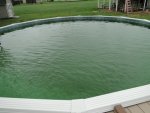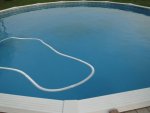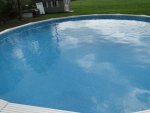So...decided to try the "no cover" this year and have had an exceptionally cold winter. Up to last week, we had a frozen pool, not sure how deep it was. The ice started melting and the water looked a little dirty to me under the ice...thought it might just be dust on top of the ice. Then as the ice really started disappearing, it showed green. I in my dumb wisdom thought that algae could not grow in water that was frozen or partially thawed. I'm telling you the water is still cold and there is still a layer of ice, but the green is all on the bottom and up the sides though water is still clear.
My problem is that my pump and all is dismantled and I know we are due for some more cold weather before the really big thaw. Am I just to sit and watch this thing get worse or should I break out the pump and have at it? I usually don't start the pump up until around May but then I've always had a cover on and never had this problem.
Thoughts?
Just to add, about two weeks ago, the water was completely clear so I know it was not a problem I closed with.
My problem is that my pump and all is dismantled and I know we are due for some more cold weather before the really big thaw. Am I just to sit and watch this thing get worse or should I break out the pump and have at it? I usually don't start the pump up until around May but then I've always had a cover on and never had this problem.
Thoughts?
Just to add, about two weeks ago, the water was completely clear so I know it was not a problem I closed with.


 [attachment=2:2ltzqn2o]DAY 1.JPG[/attachment:2ltzqn2o][attachment=1:2ltzqn2o]DAY 2.JPG[/attachment:2ltzqn2o][attachment=0:2ltzqn2o]DAY 3.JPG[/attachment:2ltzqn2o]
[attachment=2:2ltzqn2o]DAY 1.JPG[/attachment:2ltzqn2o][attachment=1:2ltzqn2o]DAY 2.JPG[/attachment:2ltzqn2o][attachment=0:2ltzqn2o]DAY 3.JPG[/attachment:2ltzqn2o]

